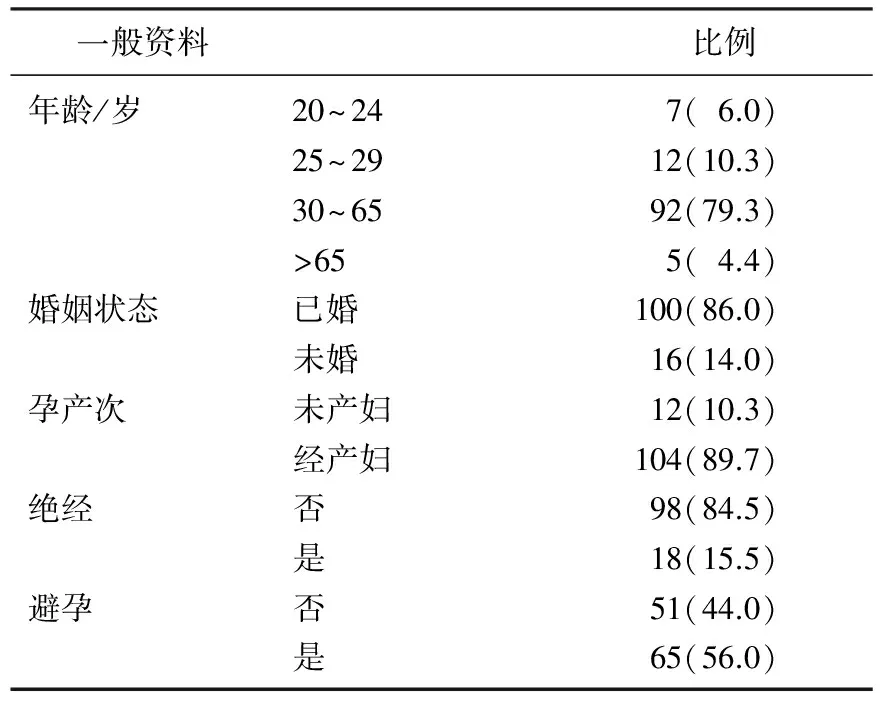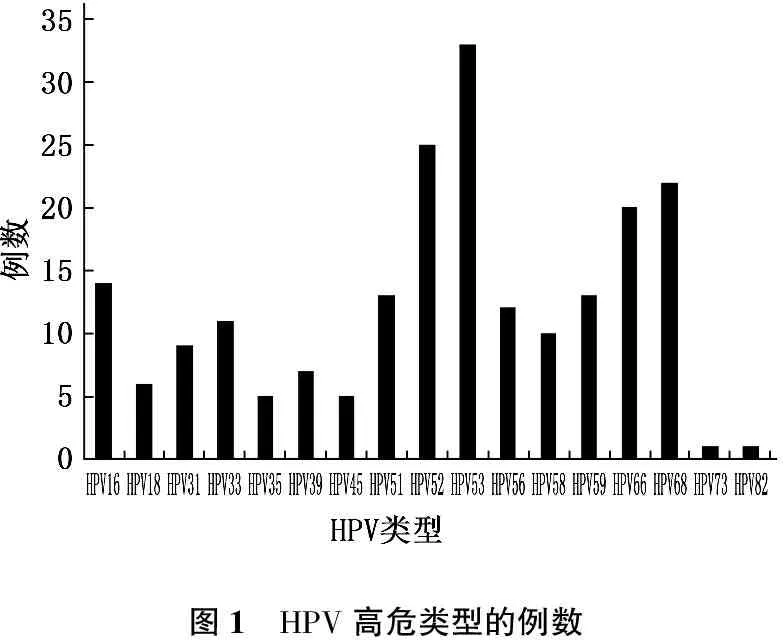宫颈上皮内瘤变Ⅰ与人类乳头状病毒感染型别的关系
苏 莉, 于澎静, 夏 林
(江苏省扬中市人民医院 妇产科, 江苏 扬中, 212200)
宫颈上皮内瘤变Ⅰ与人类乳头状病毒感染型别的关系
苏 莉, 于澎静, 夏 林
(江苏省扬中市人民医院 妇产科, 江苏 扬中, 212200)
目的评价扬中地区宫颈上皮内瘤变Ⅰ(CINⅠ)患者人类乳头状病毒(HPV)持续感染及消退型别特异性。方法选择116例确诊为CINⅠ的患者。分析患者HPV分型,每4个月随访TCT、HPV检测,记录HPV持续感染及消退时间。结果高危HPV中, HPV53(n=33)是最常见的亚型,其次分别是HPV52(n=25)、HPV68(n=22)、HPV66(n=20)、HPV16(n=14)。HPV多重感染常见, 78例(67.2%)多重感染, 38例(32.8%)单一感染。多重感染中,双重感染最常见(n=36,46.2%), 其次是三重感染(n=28,35.9%)、四重感染(n=10,12.8%)、五重感染(n=3, 3.8%)。10种最常见高危HPV中HPV16自行消退时间最长,平均为10.3月。结论扬中地区CINⅠ患者中HPV16是最常见的持续感染亚型。
宫颈上皮内瘤变; 人类乳头状病毒; 基因型别
目前人类乳头状病毒(HPV)型别超过80种,进一步分为高危型及低危型,低危型与生殖道尖锐湿疣有关,高危型与浸润性宫颈癌有关。持续性高危HPV感染是宫颈上皮内瘤变(CIN)、浸润性宫颈癌发生发展的重要病因。本研究探讨扬中地区CINⅠ患者HPV持续感染及消退型别的特异性,分析CINⅠ与HPV感染型别关系,现报告如下。
1 资料与方法
1.1 一般资料
选择2009年1月—2013年12月扬中市人民医院妇产科经组织病理学确诊为CINⅠ的患者138例,回顾性分析所有患者HPV分型,去除妊娠者、此前宫颈手术者,毎4个月随访TCT、HPV,检测必要时行阴道镜检查及组织活检。记录HPV持续感染及消退时间。138例患者中, 22例因随访时间少于8个月剔除。共入组116例患者,平均随访时间16个月,一般情况见表1。

表1 11例患者一般资料分析[n(%)]
1.2 方法
取样避开月经期, 3 d内没有阴道内用药或冲洗, 24 h内无性生活; 扩阴器充分暴露宫颈,棉拭子擦去宫颈口过多的分泌物,宫颈刷在宫颈口顺时针旋转3~5圈,取出放入专用HPV采样管中; 4℃保存,在2周内进行检测。HPV-DNA分型测定采用深圳亚能生物技术有限公司提供的HPV基因分型检测试剂盒。
通过提取临床样本病毒DNA,经过PCR-反向点杂交法、诊断脱落细胞标本中的23种HPV病毒DNA分子的存在。23种常见型别精确分型检测包括, 17种高危型别: HPV16、18、31、33、35、39、45、51、52、53、56、58、59、66、68、73、82; 6种低危型别: HPV6、11、42、43、81、83。
1.3 统计学方法
采用SPSS 17.0软件包进行统计分析。实验数据中部分采用统计学描述的方法,计数资料用率表示,率的比较采用χ2检验,以P<0.05为差异有统计学意义。
2 结 果
2.1 HPV各亚型分布情况
所有23种HPV亚型分布情况见图1。高危HPV中, HPV53(n=33)是最常见的亚型,其次分别是HPV52(n=25)、HPV68(n=22)、HPV66(n=20)、HPV16(n=14); 低危HPV中, HPV81(n=27)是最常见的亚型。HPV多重感染常见, 78例(67.2%)多重感染, 38例(32.8%)单一感染。多重感染中,双重感染最常见(n=36, 46.2%), 其次是三重感染(n=28, 35.9%)、四重感染(n=10, 12.8%)、五重感染(n=3, 3.8%)。>五重感染仅1例(1.3%)。

图1 HPV高危类型的例数
2.2 高危HPV各亚型自然转归
10种最常见高危HPV消退的平均时间见图2,其中HPV16自行消退时间最长,平均为10.3月,伴随HPV自然消退的过程常有病变的清除。共13例出现细胞学或病理的升级。10例出现细胞学升级,其中6例从未明确诊断意义的不典型鳞状上皮细胞(ASCUS)进展为低度鳞状上皮内瘤变(LSIL), 2例从正常进展为LSIL, 1例从正常进展为高度鳞状上皮内瘤变(HSIL); 3例出现病理的升级,其中2例进展为CINⅢ, 1例进展为CINⅡ。

图2 不同HPV类型的平均消退时间
3 讨 论
本研究观察了扬中地区CINⅠ患者HPV持续感染及消退型别特异性。以往有研究[1-3]报道了HPV感染与CIN及浸润性宫颈癌之间的关系,但对于HPV的认识还不全面,这些研究的局限性在于存在很多影响结果的可变因素,如不同国家、不同地区宫颈癌发病率存在地理差异性,还有HPV感染的个体易感性。
与以往报道不同,本研究显示扬中地区CINⅠ患者HPV53、52、68为最常见感染亚型。一项世界范围内的Meta分析[4-6]显示, 70%浸润性宫颈癌与HPV16(55%)及18(15%)有关,其次是HPV31、33、45、52、58。亚洲人中感染HPV58、52更易发展为浸润性宫颈癌, HPV58、52在中国、日本等亚洲国家有较高的检出,而在世界其他地区很少或者没有检出[7-9]。
本研究中HPV53为最常见感染亚型,但HPV16是最常见的持续感染亚型。HPV感染常无临床症状,平均持续时间为8~12个月,其中低危型平均清除时间为5~6个月,高危型平均清除时间为8~14个月, 50%~90%的HPV感染可在数月至2年内被机体清除,而HPV16或18型持续感染的时间会更长[10]。在前瞻性研究[11]中, HPV16更多表现为持续感染,较其他高危HPV更易进展为CINⅢ。Meta分析[12]显示HPV16、58、18是高级别病变中常见的3个亚型, 62%的高级别病变、31.4%的低级别病变与这些亚型有关。这些结果提示HPV亚型检测在高危HPV导致的CINⅠ中具有进一步分流意义,对于持续HPV16阳性的CINⅠ需要重视。本研究显示HPV多重感染常见,特别是双重感染(46.2%)。没有确切的证据能够表明是否一种HPV感染后更易继发第二种HPV感染[13-14]。有报道[15]显示HPV16、18感染者较未感染者继发感染HPV58的可能性要高出7倍。本研究样本量较少、随访时间相对较短,但是实验结果显示高危HPV各亚型之间存在差别,对CINⅠ的临床治疗有一定意义。
[1] Mittal S, Basu P, Muwonge R, et al. Risk of high-grade precancerous lesions and invasive cancers in high-risk HPV-positive women with normal cervix or CIN 1 at baseline-A population-based cohort study[J]. Int J Cancer, 2017, 140(8): 1850-1859.
[2] Catarino R, Vassilakos P, Jinoro J, et al. Human papillomavirus prevalence and type-specific distribution of high- and low-risk genotypes among Malagasy women living in urban and rural areas[J]. Cancer Epidemiol, 2016, 42: 159-66.
[3] Joste N E, Ronnett B M, Hunt W C, et al. Human papillomavirus genotype-specific prevalence across the continuum of cervical neoplasia and cancer[J]. Cancer Epidemiol Biomarkers Prev, 2015, 24(1): 230-40.
[4] Monsonego J, Cox JT, Behrens C, et al. Prevalence of high-risk human papilloma virus genotypes and associated risk of cervical precancerous lesions in a large U. S. screening population: data from the ATHENA trial[J]. Gynecol Oncol, 2015, 137(1): 47-54.
[5] Paolini F, Curzio G, Melucci E, et al. Human papillomavirus 16 E2 interacts with neuregulin receptor degradation protein 1 affecting ErbB-3 expression in vitro and in clinical samples of cervical lesions[J]. Eur J Cancer, 2016, 58: 52-61.
[6] Andersson S, Mints M, Wilander E. Results of cytology and high-risk human papillomavirus testing in females with cervical adenocarcinoma?in situ[J]. Oncol Lett, 2013, 6(1): 215-219.
[7] 赵颖, 林敏, 潘美晨, 等. HPV分型及高危型定量检测在宫颈病变中的意义[J]. 分子诊断与治疗杂志, 2013, 5(2): 102-106.
[8] Liu Y, Pan Y, Gao W, et al. Whole-Genome Analysis of Human Papillomavirus Types 16, 18, and 58 Isolated from Cervical Precancer and Cancer Samples in Chinese Women[J]. Sci Rep, 2017, 7(1): 263-9.
[9] Murakami I, Fujii T, Dan K. Methylation of human papillomavirus-52 and -58 is a candidate biomarker in cervical neoplasia[J]. J Clin Virol, 2013, 58(1): 149-54.
[10] Saslow D, Solomon D, Lawson H W, et al. American Cancer Society for Colposcopy and Cervical Pathology and American Cancer Society for clinical pathology screening guiedelines for the prevention and early detection of cervicao cancer[J]. Am J Clin Pathol, 2012, 1377(4): 516-542.
[11] Mendes de Oliveira C, Levi JE. The Biological Impact of Genomic Diversity in Cervical Cancer Development[J]. Acta Cytol, 2016, 60(6): 513-517.
[12] Kim M J, Kim J J, Kim S. Type-specific prevalence of high-risk human papillomavirus by cervical cytology and age: data from the health check-ups of 7, 014 Korean women[J]. Obstet Gynecol Sci, 2013, 56: 110-20.
[13] De Brot L, Pellegrini B, Moretti S T, et al. Infections with multiple high-risk HPV types are associated with high-grade and persistent low-grade intraepithelial lesions of the cervix[J]. Cancer, 2017, 125(2): 138-143.
[14] Gustinucci D, Passamonti B, Cesarini E. Role of p16(INK4a) cytology testing as an adjunct to enhance the diagnostic specificity and accuracy in human papillomavirus-positive women within an organized cervical cancer screening program[J]. Acta Cytol, 2012, 56(5): 506-14.
[15] Mbatha J N, Taylor M, Kleppa E. High-risk human papillomavirus types in HIV-infected and HIV-uninfected young women in KwaZulu-Natal, South Africa: implications for vaccination[J]. Infect Dis (Lond), 2017, 12: 1-8.
CorrelationbetweencervicalintraepithelialneoplasiaⅠandtypeofhumanpapillomavirusinfection
SULi,YUPengjing,XIALin
(DepartmentofGynecologyandObstetrics,YangzhongPeople′sHospital,Yangzhong,Jiangsu, 212200)
ObjectiveTo evaluate the specificity of continuous infection and decline of type of human papillomavirus (HPV) in women with cervical intraepithelial neoplasiaⅠ (CINⅠ) in Yangzhong area.MethodsA total of 116 patients with CINⅠwere selected. HPV typing was analyzed, and TCT and HPV were followed up every 4 months. The duration of HPV infection and regression time were recorded.ResultsIn the cases with high-risk HPV, HPV53 (n=33) was the most common subtype, and followed by HPV52 (n=25), HPV68 (n=22), HPV66 (n=20) and HPV16 (n=14). Multiple infections were common in HPV infection, including multiple infection in 78 cases (67.2%), and single infection in 38 cases (32.8%). In the multiple infections, dual infection was the most common type (n=36, 46.2%), followed by triple infections (n=28, 35.9%), four infections (n=10, 12.8%), and five infections (n=3, 3.8%). The HPV16 regression time was the longest in the ten most common high-risk HPV, with an average of 10.3 months.ConclusionHPV 16 is the most common persistent HPV genotypes in women with CINⅠin Yangzhong area.
cervical intraepithelial neoplasia; human papillomavirus; genotype
R 711.74
A
1672-2353(2017)21-052-03
10.7619/jcmp.201721015
2017-05-07
江苏省镇江市社会发展指导性项目(FZ2015058)

